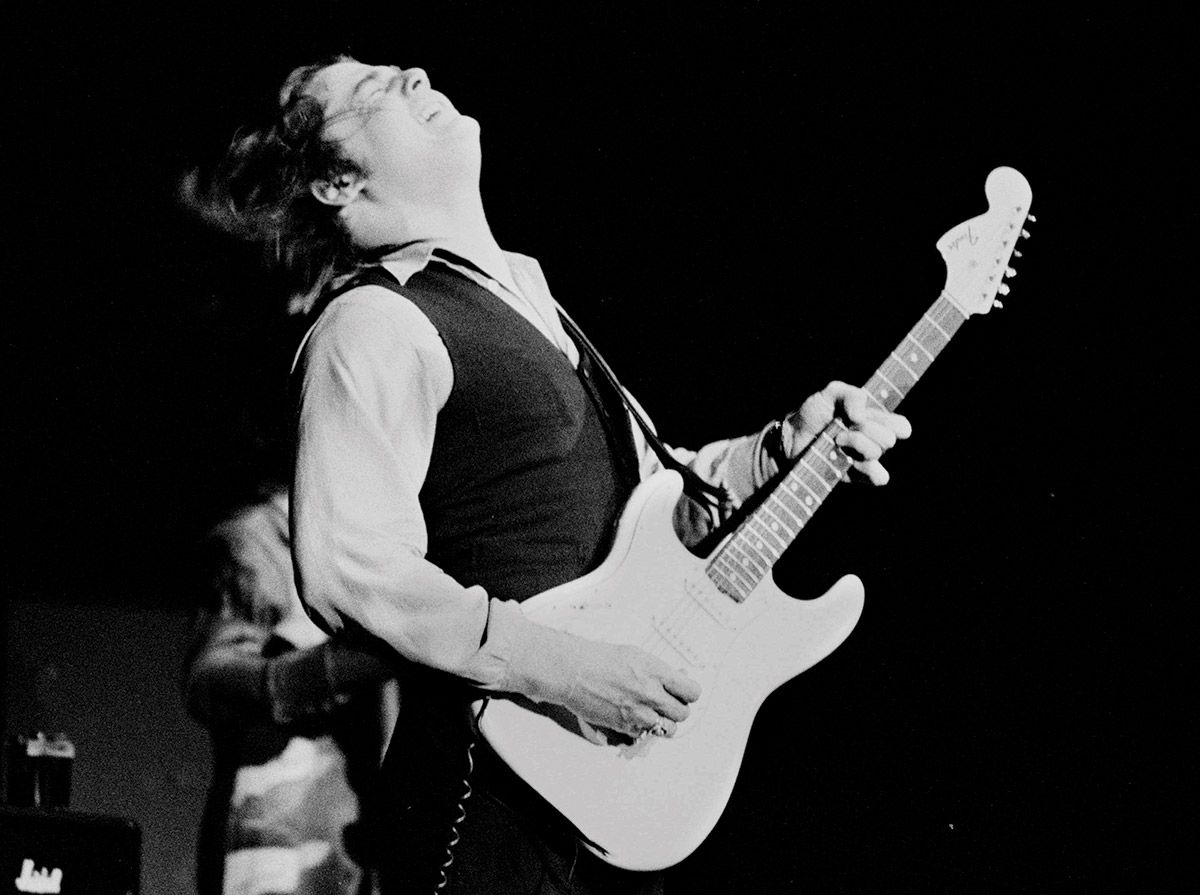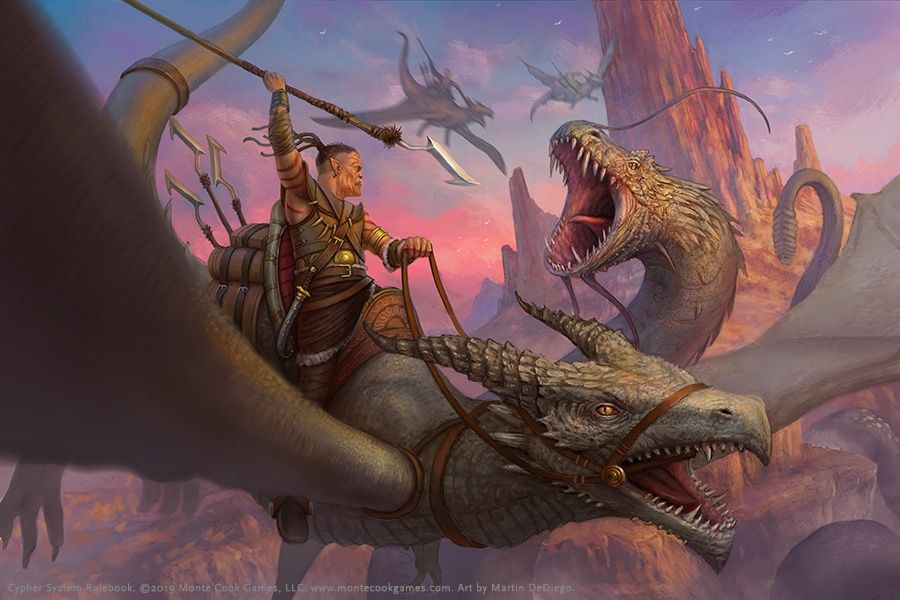Hello folks! This is a supplemental post to answer some questions you may have had about the Cypher System role-playing game, why I’ve chosen it as the “official” system for Against the ’70s, and an explanation of some of terms that come up in the movie posts. Look for a new post on 1977’s The Car tomorrow!
 The cover of the Cypher System Rulebook, Revised Edition.
The cover of the Cypher System Rulebook, Revised Edition.
What is the Cypher System? The Cypher System, created by Monte Cook, is a relatively new role-playing game, debuting in 2013 with Numenera. In 2016, the system was extracted from the world and presented in a “generic” or “universal” format with the Cypher System Core Book. A revised version of the Core Book, co-written with Bruce R. Cordell and Sean K. Reynolds, was released in 2019; this is the book I will be using going forward. The system currently “powers” Numenera (science fantasy) Gods of the Fall (more fantasy, about becoming new gods), Predation (time travel to dinosaur times), Unmasked, and Claim the Sky (both variations on superheroes).
How does the Cypher System work? The following is simplified for space, but not by much. The character creation system is generally straightforward. Players select, from a large menu of choices, an adjective (the descriptor), a noun (the type), and a verb (the focus), which creates a sentence that describes the character. For example, you could have an Intuitive Warrior who Moves Like a Cat, or the more mundane (but no less effective) Jovial Speaker who Interprets the Law, or even the bizarre Foolish Adept who Exists in Two Places at Once. (For the Dungeons & Dragons players out there, descriptor is kind of like race, type is kind of like class, and focus is kind of like a subclass.) These three choices determine the values of the character’s stats, which are Might, Speed, and Intellect, as well as their skills and special powers.
 This is the cover for the first edition. You can still use it to run the game! The revised edition just has more options.
This is the cover for the first edition. You can still use it to run the game! The revised edition just has more options.
The basic task resolution system is also dead simple. All enemies or challenges are rated on a difficulty scale from 1-10, from simple to almost impossible. That score, times three, is the target number that needs to be rolled (or higher) on a d20 to successfully hit the enemy or jump the chasm or what have you. A score of 7 or more translates to a target number of 21 or more, which can’t be rolled on a d20; such actions will automatically fail. However, a character can use skills and other methods to reduce the difficulty. So a chasm that’s difficulty 7 (needing a 21 on a d20) would normally be impossible, but a character that had really good jumping skills and other benefits might be able to lower that difficult to a 4, thus needing a 12+ to clear the gap.
There’s more, of course, but that’s the basic idea. There’s a free rules primer that explains all this and more that you can download from Monte Cook Games.
Why did you choose the Cypher System for Against the ’70s? The first reason is that the foci (verbs) aspect of generating characters allow me to enforce the ’70s setting that might be difficult in other systems. The foci can get weirdly specific; I mentioned Exists in Two Places at Once, but there’s also Bears a Halo of Fire, Emerged from the Obelisk, and Shreds the Walls of the World. I love this, because it means, when creating my own for Against the ’70s, I too can get weirdly specific, drilling down into a famous ’70s movie character or archetype or even just idea, and make that foci blossom, instead of say, trying to work it into a D&D-style figher/wizard/cleric/thief structure. In the future, look for new foci such as Has an Orangutan for a Friend, Is the Actual Child of Satan, and Speaks of the Pompatus of Love1.
 AKA The Space Cowboy, The Gangster of Love, “Maurice.”
AKA The Space Cowboy, The Gangster of Love, “Maurice.”
Secondly, a lot of the mechanical bookkeeping that can occupy a GM’s attention (and away from describing and engaging with the adventure at hand) is reduced here. My personal GM dream is to be able to sit back and talk and run the game and let the players handle the “crunch” of the system; the Cypher System is about 90% of the way there2. One way this happens is that the 1-10 system for determining a challenge rating for an enemy also generates the enemy’s health, how difficult they are to hit, how likely they are to hit the player characters, and the amount of damage they do. All of this can be done in the GM’s head. (These numbers can be modified to create unique creatures, but don’t have to be.)
But here’s the one that really sold me: the GM never rolls for the enemies to see if they hit the characters; instead, the players roll to avoid being hit. This distinction may be subtle, but the effect is tremendous. In Dungeons & Dragons, the characters have what’s called an Armor Class; this is the number the monsters must roll to hit the characters, and it generally remains static over the course of a session. The DM rolls for the monsters, and if they meet or beat the number, the character is hit. There is often very little the player can do about this other than hope for a miss. In the Cypher System, not only does the player make the roll to determine if they’ve been hit (which I believe makes a difference psychologically), they will often have the option to spend points from their stats to decrease the difficulty. The player no longer has to just “sit and take it” — they actually have some agency over their fate in combat.
To be fair, some people find these things bugs, not features. But I find them awesome and inspiring. Again, here’s a free primer on the rules, and here’s the DriveThruRPG link to purchase the Cypher System Rulebook Revised in PDF. If you’re the type that likes to get their information in a pleasant video, this one from the Dungeon Newb’s Guide is the one that introduced me to the game and persuaded me to take a chance on it.
 From the DriveThruRPG page for the Cypher System Rulebook Revised. Don’t mess with Jim Henson’s Nosferatu Babies.
From the DriveThruRPG page for the Cypher System Rulebook Revised. Don’t mess with Jim Henson’s Nosferatu Babies.
What do the various statistics for the creatures mean? Every creature has around 14 “stats.” Only a few of these are important when the dice hit the table; most can be memorized. Generally, once you know the Level, you’re good to go.
Level is simply the number between 1 and 10 that describes how difficult a creature is to hit and how easy it is for it to hit in turn. If you recall, this number times three is the target number for any action associated with the creature.
Description is just that, what the creature looks like. For creatures taken from movies, I’ve tried to give as detailed and pedantic a description as I can muster.
Motive is what causes the creature to act like it does, usually to account for why it’s attacking. Does it want food? Or is it just an asshole? And so forth.
Environment is where the creature is found.
Health is basically the same as hit points in D&D; here, Health is usually determined by three times the creature’s level (or in other words, the same number as the target number), but can be modified up or down as the GM sees fit.
Damage Inflicted is the amount of damage the creature does when it hits. All damage in this system is fixed, meaning it’s always the same number, never determined by a die roll. A creature’s damage is usually, get this, the same as its level. (I presume you can see why making up a monster in this system is easy; all you need is one number.)
Armor is the amount of damage that is subtracted from an attack before applying to the creature’s Health. Not all creatures have Armor.
Movement tells the GM how far the creature can move on its turn. Distances are abstracted in this system; the most commonly used are Immediate range (within 10 feet), Short range (10-50 feet), and Long Range (50-100 feet).
 From the DriveThruRPG page for the Cypher System Rulebook Revised. Just breaking up the ol’ text with a picture. Pretty nice, huh? Martin DeDiego is a damn fine artist.
From the DriveThruRPG page for the Cypher System Rulebook Revised. Just breaking up the ol’ text with a picture. Pretty nice, huh? Martin DeDiego is a damn fine artist.
Modfications are where its noted where the creature might differ in certain ways contrary to its level. For example, a very large Level 5 monster might be considered Level 3 when the characters try to hit it; in other words, easier to hit because it’s so big. Or a fast Level 2 monster might be considered Level 4 when it attacks the characters. If a creature has skills, these are noted here.
Combat is a description of the kind of attacks the creature makes and the kind of tactics it uses. If there are any special rules for its attacks, those go here as well.
Interaction is how the creature communicates with the characters, especially if they want to avoid fighting.
Use is an quick adventure idea, expressed in a sentence or two, that shows how to bring the creature into a story.
Loot is the treasure, if any, the creature might have on them. Some treasures are in the form of cyphers (one-use items, like a magic potion) or artifacts (like cyphers, but more powerful and usually more than one use.)
GM Intrusions need a little explanation. During a session, the GM may attempt a GM Intrusion; this is something that would make the character’s situation more difficult, or at least more complicated, in order to create a more compelling story. The GM offers the player an experience point as a consolation for this. However, if a player rolls a one when attempting a task, the GM may use an GM Intrusion and need not give the player an experience point.
Conclusion. As I hope is apparent, the Cypher System is pretty easy to run, pretty easy to write for, while still offering enough crunch for players and enough structure for GMs to create their own worlds. While I may branch out to other systems, depending on the context (i.e., movie), for now, I will be working primarily with the Cypher System.
Originally posted 11/11/21 on Substack
ETA 12/30/23: I created Has an Orangutan for a Friend for my writeup on Every Which Way But Loose. I haven’t written Is the Actual Child of Satan nor the Steve Miller one, despite all the references to it in this post. Maybe this year’s the year. Flies Like an Eagle.↩︎
The system Powered by the Apocalypse actually does this 100%, but I find designing for the player side of things in that system more difficult, so that’s one reason I didn’t choose it.↩︎